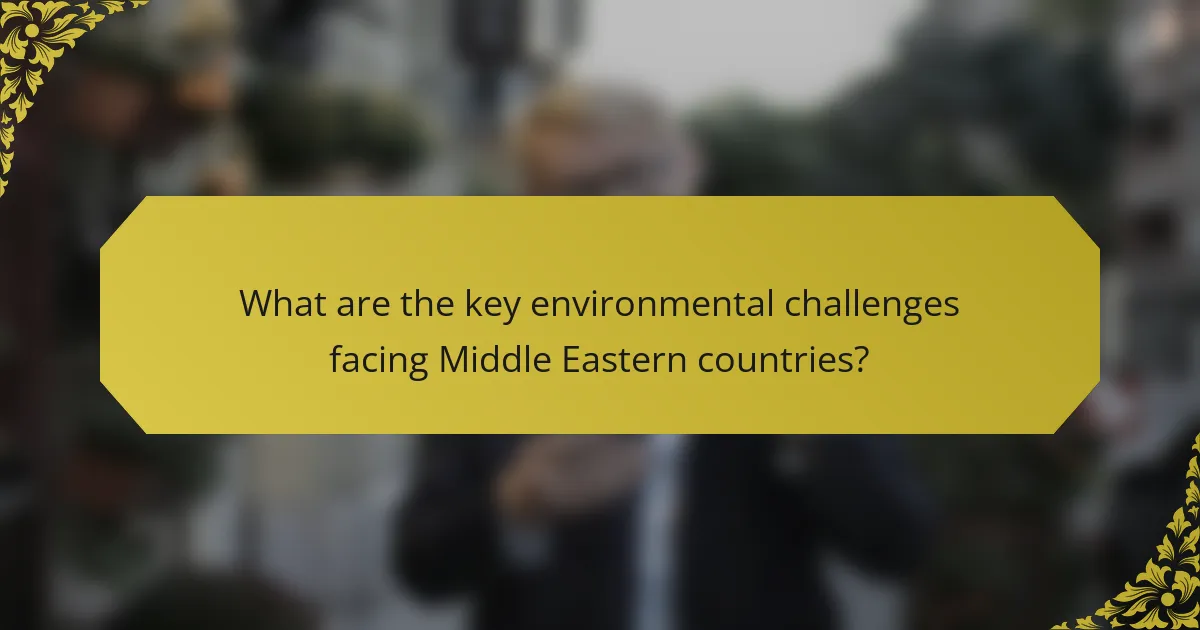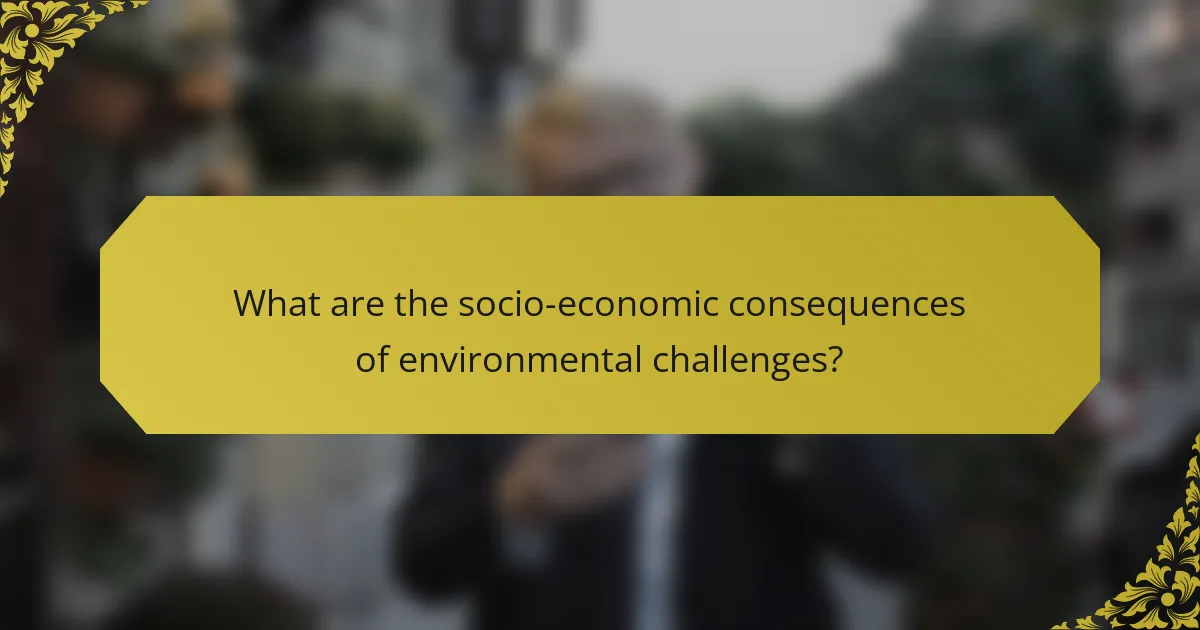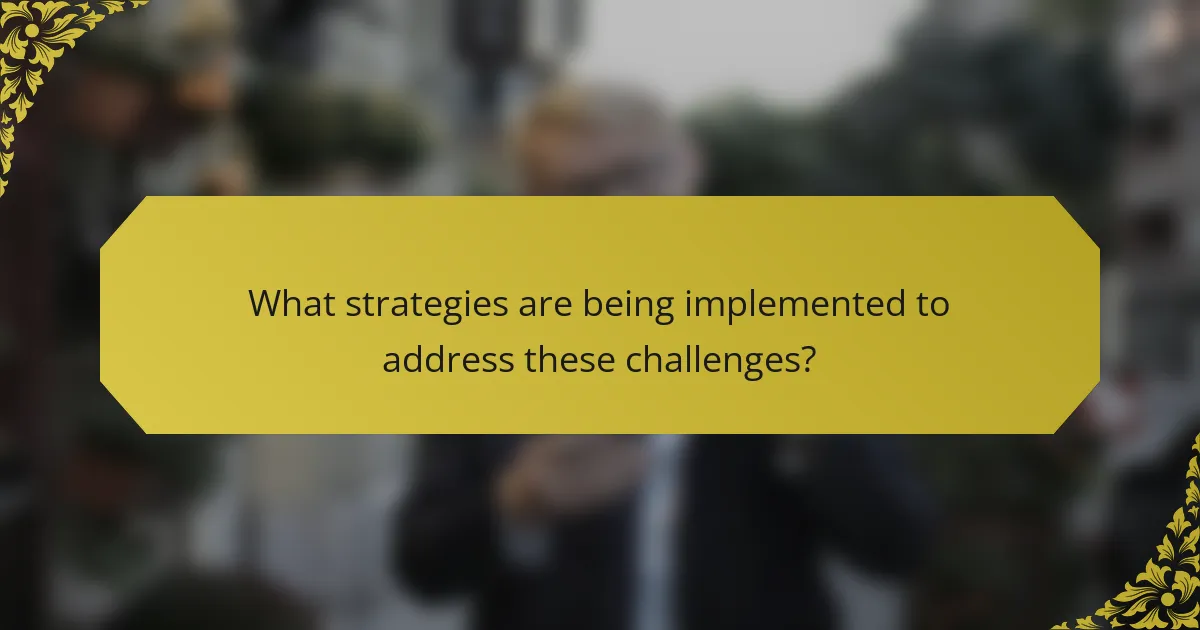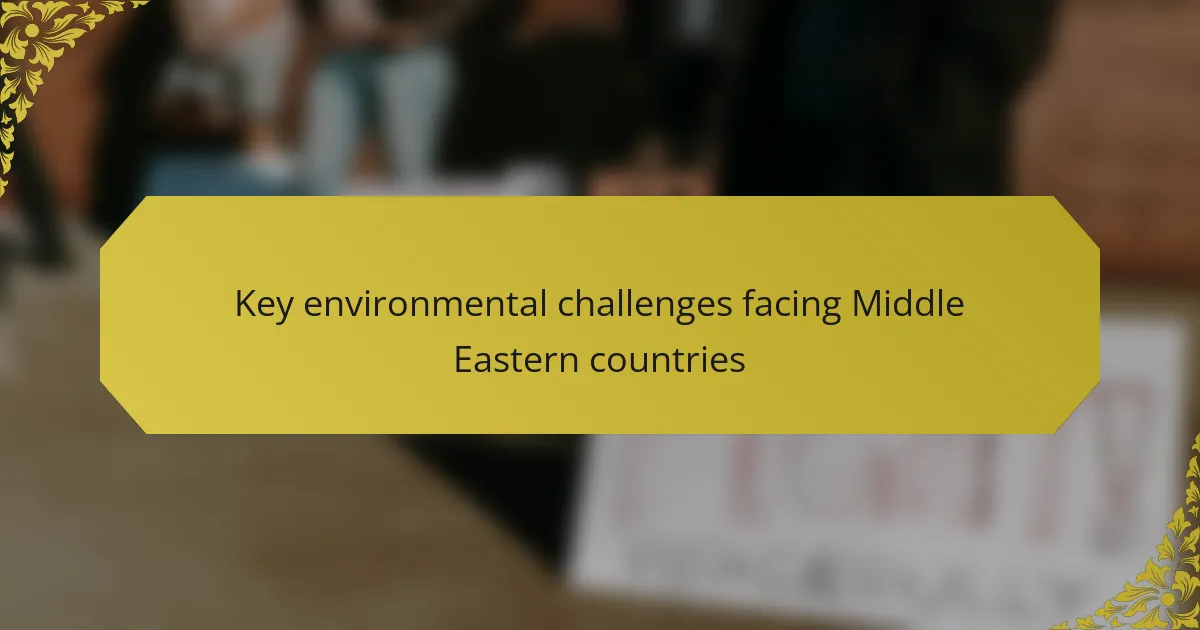
What are the key environmental challenges facing Middle Eastern countries?
Key environmental challenges facing Middle Eastern countries include water scarcity, desertification, and air pollution. Water scarcity affects over 60% of the population in the region. This is due to over-extraction of groundwater and climate change. Desertification threatens agricultural productivity and biodiversity. Approximately 90% of the land is arid or semi-arid, making this issue critical. Air pollution results from industrial emissions and vehicle exhaust. Major cities often exceed safe air quality levels, impacting public health. These challenges are exacerbated by rapid urbanization and population growth. Addressing these issues is essential for sustainable development in the region.
How do climate change impacts manifest in the Middle East?
Climate change impacts in the Middle East manifest through increased temperatures, reduced rainfall, and intensified droughts. Average temperatures in the region have risen by approximately 1.5 degrees Celsius since the early 20th century. This rise contributes to extreme heat events, with some areas experiencing summer temperatures exceeding 50 degrees Celsius. Additionally, rainfall patterns have become more erratic, leading to a decrease in annual precipitation by up to 30% in some regions. Drought conditions have intensified, affecting water availability for agriculture and drinking. The Intergovernmental Panel on Climate Change (IPCC) reports that these changes threaten food security and increase the risk of conflict over scarce resources. Coastal areas also face rising sea levels, which threaten infrastructure and ecosystems. Overall, climate change poses significant risks to the stability and sustainability of Middle Eastern countries.
What specific climate patterns are affecting the region?
Rising temperatures and increasing aridity are specific climate patterns affecting the Middle Eastern region. Average temperatures in the area have risen by approximately 1.5 degrees Celsius since the early 20th century. This warming trend exacerbates drought conditions, leading to severe water scarcity. The frequency of heatwaves has also increased, impacting agriculture and public health. Additionally, changing precipitation patterns result in unpredictable rainfall, often leading to flooding in some areas and prolonged dry spells in others. These climate changes threaten food security and water resources, vital for the region’s population.
How does rising temperature influence water availability?
Rising temperatures significantly reduce water availability. Higher temperatures increase evaporation rates from water bodies and soil. This process depletes surface water and groundwater resources. In arid and semi-arid regions, such as the Middle East, this effect is pronounced. For instance, a study by the Intergovernmental Panel on Climate Change (IPCC) indicates that global warming could lead to a decrease in freshwater resources. Research shows that increased heat can also alter precipitation patterns, leading to less reliable rainfall. This further exacerbates water scarcity issues in affected regions. Consequently, rising temperatures pose a serious threat to water security in the Middle East.
What role does water scarcity play in environmental challenges?
Water scarcity significantly exacerbates environmental challenges. It leads to decreased agricultural productivity, threatening food security. In arid regions, such as the Middle East, water scarcity can result in desertification. This process degrades land quality and reduces biodiversity. Furthermore, limited water resources strain ecosystems, impacting wildlife habitats. Water scarcity also contributes to increased competition for resources, leading to social conflicts. According to the United Nations, over 1.2 billion people live in areas of physical water scarcity. This statistic highlights the severity of the issue on a global scale. In the Middle East, countries face particularly acute water stress due to climate change and population growth.
How is water scarcity affecting agriculture in the Middle East?
Water scarcity significantly impacts agriculture in the Middle East. It reduces crop yields due to insufficient irrigation. Many regions experience severe droughts, limiting water availability for farming. This situation forces farmers to adopt less sustainable practices. For example, over-extraction of groundwater occurs to meet immediate needs. According to the Food and Agriculture Organization, the region’s water resources are among the lowest globally. Consequently, food security is threatened as agricultural productivity declines. Additionally, rising temperatures exacerbate water scarcity, further challenging agricultural sustainability.
What are the implications of water scarcity on urban areas?
Water scarcity significantly impacts urban areas by straining resources and infrastructure. Urban populations depend on reliable water supplies for drinking, sanitation, and economic activities. Limited water availability can lead to increased competition among residents and industries. This competition often results in higher water prices and potential conflicts.
Additionally, water scarcity can hinder urban development and growth. Construction projects may face delays due to insufficient water for construction needs. Public health issues may arise as sanitation systems become overwhelmed or ineffective. The lack of water can also reduce agricultural productivity in urban fringe areas, affecting food supply chains.
According to the United Nations, over 100 million people in the Middle East face water scarcity, exacerbating these urban challenges. This situation calls for urgent policy interventions and sustainable management practices to mitigate the implications of water scarcity on urban areas.
How do desertification and land degradation impact Middle Eastern ecosystems?
Desertification and land degradation severely impact Middle Eastern ecosystems by reducing biodiversity and altering habitats. These processes lead to soil erosion, which diminishes land productivity. Consequently, agricultural yields decline, threatening food security in the region. Water scarcity intensifies as vegetation cover decreases, affecting both flora and fauna. The loss of plant life disrupts local wildlife, leading to habitat fragmentation. Additionally, desertification increases the frequency of dust storms, which can harm human health and agricultural activities. According to the United Nations Environment Programme, over 60% of the Middle East is at risk of desertification, emphasizing the urgency of addressing these challenges.
What are the primary causes of desertification in the region?
The primary causes of desertification in the region include climate change, unsustainable agricultural practices, and deforestation. Climate change leads to increased temperatures and reduced rainfall, exacerbating arid conditions. Unsustainable agricultural practices, such as overgrazing and improper irrigation, deplete soil nutrients and degrade land quality. Deforestation removes protective vegetation, increasing soil erosion and reducing moisture retention. According to the United Nations Convention to Combat Desertification, these factors contribute significantly to land degradation in the Middle East.
How does land degradation affect biodiversity in Middle Eastern countries?
Land degradation significantly reduces biodiversity in Middle Eastern countries. It leads to habitat loss, which directly affects various species. Soil erosion and desertification diminish the land’s ability to support plant and animal life. Overgrazing and unsustainable agricultural practices further exacerbate these issues. The United Nations reports that desertification threatens 20% of the region’s land. This loss of habitat results in declining populations of native species. In turn, this disrupts ecosystems and the services they provide. Conservation efforts are critical to mitigate these impacts and preserve biodiversity.

What are the socio-economic consequences of environmental challenges?
Environmental challenges lead to significant socio-economic consequences. These challenges include water scarcity, air pollution, and climate change. Water scarcity reduces agricultural productivity, impacting food security. Air pollution affects public health, increasing healthcare costs and reducing workforce productivity. Climate change exacerbates extreme weather events, leading to infrastructure damage and economic losses. In the Middle East, these factors can drive migration, as people leave affected areas for better opportunities. The World Bank estimates that environmental degradation could cost the region billions in economic losses by 2050. Thus, addressing environmental challenges is crucial for sustaining socio-economic stability in the Middle East.
How do environmental challenges affect public health in the region?
Environmental challenges significantly affect public health in the region. Air pollution from industrial emissions and vehicle exhaust leads to respiratory diseases. Water scarcity impacts sanitation and can lead to waterborne illnesses. Extreme heat increases the risk of heat-related illnesses, particularly among vulnerable populations. Urbanization contributes to overcrowding, exacerbating the spread of infectious diseases. Climate change intensifies these issues, creating more severe weather events that disrupt health services. Studies show that regions with high pollution levels see increased hospital admissions for respiratory conditions. The World Health Organization reports that environmental factors contribute to a substantial percentage of health problems in the Middle East.
What are the health risks associated with air pollution in urban areas?
Air pollution in urban areas poses significant health risks. It is linked to respiratory diseases such as asthma and chronic obstructive pulmonary disease (COPD). Exposure to pollutants can lead to cardiovascular problems, including heart attacks and strokes. Airborne toxins are associated with increased rates of lung cancer. Vulnerable populations, such as children and the elderly, are particularly at risk. Studies show that urban areas with high pollution levels see a rise in hospital admissions for respiratory issues. According to the World Health Organization, air pollution causes approximately 7 million premature deaths annually worldwide. These statistics highlight the urgent need for addressing air quality in urban settings.
How does water scarcity lead to health issues among populations?
Water scarcity leads to health issues among populations by limiting access to clean drinking water. Insufficient water supply increases the risk of waterborne diseases such as cholera and dysentery. According to the World Health Organization, approximately 2.2 million people die each year from diarrheal diseases linked to unsafe water. Lack of water also affects sanitation and hygiene practices, leading to further health complications. Populations in water-scarce regions often resort to using contaminated sources, exacerbating health risks. Additionally, malnutrition can occur due to reduced agricultural productivity from insufficient irrigation. This creates a cycle of poor health and economic instability.
What economic impacts arise from environmental challenges?
Environmental challenges lead to significant economic impacts. These challenges include water scarcity, air pollution, and climate change. Water scarcity affects agricultural productivity, reducing crop yields. This results in higher food prices and increased reliance on food imports. Air pollution leads to health issues, increasing healthcare costs. Climate change causes extreme weather events, damaging infrastructure and disrupting trade. The World Bank estimates that climate change could cost the Middle East 14% of GDP by 2050. These economic impacts strain national budgets and hinder sustainable development.
How does climate change affect tourism in Middle Eastern countries?
Climate change significantly affects tourism in Middle Eastern countries. Rising temperatures lead to increased heatwaves, making outdoor activities less appealing. Water scarcity, exacerbated by climate change, threatens the availability of resources for tourists. Coastal areas face erosion and flooding, impacting beach tourism. Extreme weather events can disrupt travel plans and damage infrastructure. A study by the United Nations World Tourism Organization highlights that climate change could reduce tourist numbers by 30% in some regions. This decline impacts local economies that rely heavily on tourism revenue.
What are the financial implications of water resource management?
Water resource management has significant financial implications. Effective management can lead to cost savings in water supply and treatment. It reduces the need for expensive infrastructure projects. Sustainable practices can lower operational costs for utilities. Investing in water conservation technologies can yield long-term economic benefits. The World Bank estimates that every dollar spent on water management can generate up to $4 in economic returns. Poor management, conversely, can lead to increased costs due to water scarcity and associated health issues. In the Middle East, where water is scarce, these financial implications are particularly pronounced.

What strategies are being implemented to address these challenges?
Middle Eastern countries are implementing various strategies to address key environmental challenges. These strategies include investing in renewable energy sources, such as solar and wind power. For instance, the United Arab Emirates aims to generate 50% of its energy from clean sources by 2050. Additionally, countries are enhancing water management practices to combat water scarcity. Desalination technologies are being expanded, with Saudi Arabia leading in this area, producing over 3.5 million cubic meters of desalinated water daily. Furthermore, there is a focus on improving waste management systems to reduce pollution. Countries like Qatar are developing advanced recycling programs to minimize landfill waste. Lastly, regional cooperation is being fostered through initiatives like the Arab Strategy for Disaster Risk Reduction, enhancing resilience to climate impacts. These efforts collectively aim to mitigate the environmental challenges faced by the region.
How are governments responding to environmental issues in the Middle East?
Governments in the Middle East are implementing various strategies to address environmental issues. Many are focusing on renewable energy initiatives. For instance, Saudi Arabia’s Vision 2030 aims to diversify energy sources and reduce reliance on oil. The United Arab Emirates is investing heavily in solar energy projects, such as the Mohammed bin Rashid Al Maktoum Solar Park, which aims to generate 5,000 MW of solar power by 2030.
Additionally, countries are enhancing water management practices. Jordan, facing severe water scarcity, has adopted innovative irrigation techniques and wastewater recycling systems. Environmental regulations are also being strengthened across the region. Qatar has introduced laws to protect air quality and reduce emissions from industry.
Furthermore, regional cooperation is increasing. The Arab League has initiated discussions on shared environmental challenges, including climate change and desertification. These responses reflect a growing recognition of the need for sustainable development in the face of pressing environmental challenges.
What policies are in place to combat climate change?
Governments in the Middle East have implemented various policies to combat climate change. These policies include renewable energy initiatives, such as the UAE’s commitment to generate 50% of its energy from clean sources by 2050. Additionally, Saudi Arabia’s Vision 2030 aims to diversify the economy and reduce dependence on oil, promoting sustainability. Countries are also investing in energy efficiency programs to reduce carbon emissions. The Qatar National Vision 2030 emphasizes environmental sustainability and climate resilience. Furthermore, regional cooperation agreements focus on sharing best practices and technologies for climate adaptation. These efforts are supported by international agreements like the Paris Agreement, which encourages nations to set emission reduction targets.
How are water conservation efforts being promoted?
Water conservation efforts are being promoted through various initiatives and educational campaigns. Governments in the Middle East are implementing policies to encourage efficient water use. These include subsidies for water-saving technologies and regulations on water usage in agriculture. Community awareness programs educate citizens on the importance of conserving water. Schools and local organizations are also involved in promoting water conservation practices. International collaborations support technology transfer and funding for water-saving projects. Statistics show that these efforts have led to a measurable reduction in water consumption in several regions.
What role do international organizations play in addressing these challenges?
International organizations play a crucial role in addressing environmental challenges in Middle Eastern countries. They provide funding, technical assistance, and policy guidance. Organizations like the United Nations Environment Programme (UNEP) focus on sustainable development and environmental protection. They help countries implement international treaties on climate change and biodiversity. Additionally, these organizations facilitate knowledge sharing among nations. They promote best practices and innovative solutions tailored to regional needs. For example, the World Bank supports projects aimed at water management and renewable energy. Their involvement enhances local capacities to tackle pressing environmental issues effectively.
How are NGOs contributing to environmental sustainability in the region?
NGOs are significantly contributing to environmental sustainability in the region by implementing various conservation projects. They focus on reforestation efforts, which help restore degraded landscapes. Many NGOs also engage in community education programs about sustainable practices. They promote the use of renewable energy sources, reducing reliance on fossil fuels. Additionally, NGOs often collaborate with local governments to enforce environmental regulations. They conduct research to monitor biodiversity and ecosystem health. Their advocacy efforts raise awareness of climate change impacts. Overall, NGOs play a crucial role in fostering sustainable development in the region.
What partnerships exist between Middle Eastern countries and global entities?
Middle Eastern countries engage in various partnerships with global entities. These collaborations often focus on energy, technology, and environmental sustainability. For example, the United Arab Emirates partners with countries like the United States and France in renewable energy projects. Saudi Arabia collaborates with international firms on Vision 2030, aiming to diversify its economy. Qatar has established partnerships with global organizations for sustainable development initiatives. Bahrain works with international financial institutions to enhance its economic resilience. These partnerships are crucial for addressing environmental challenges, as they facilitate knowledge transfer and investment in green technologies.
What practical steps can individuals take to mitigate environmental challenges?
Individuals can mitigate environmental challenges by adopting sustainable practices. Reducing energy consumption is crucial. Simple actions like turning off lights and using energy-efficient appliances contribute significantly. Additionally, minimizing water usage helps address water scarcity, a pressing issue in the Middle East. Individuals should fix leaks and use water-saving fixtures.
Recycling and reducing waste also play a vital role. By separating recyclables and composting organic waste, individuals can decrease landfill contributions. Supporting local and sustainable products reduces carbon footprints associated with transportation.
Public transportation and carpooling reduce greenhouse gas emissions. Walking or biking for short distances further lessens environmental impact. Planting trees and maintaining green spaces improve air quality and biodiversity.
Educating oneself and others about environmental issues raises awareness and encourages collective action. Participation in community clean-up events fosters a sense of responsibility and community engagement. These practical steps collectively contribute to mitigating environmental challenges in the region.
How can citizens contribute to water conservation efforts?
Citizens can contribute to water conservation efforts by adopting sustainable practices in their daily lives. They can reduce water usage by fixing leaks and using water-efficient appliances. Additionally, citizens can practice rainwater harvesting to collect and reuse rainwater. Educating others about the importance of water conservation can amplify these efforts. Participating in community clean-up events helps protect local water sources. Furthermore, citizens can advocate for policies that promote water conservation. According to the United Nations, water scarcity affects over 40% of people globally, highlighting the urgency of individual actions.
What are some sustainable practices individuals can adopt in daily life?
Individuals can adopt several sustainable practices in daily life. Reducing single-use plastics is essential. This can be achieved by using reusable bags and containers. Conserving water is also crucial. Simple actions, like fixing leaks and taking shorter showers, make a significant impact. Additionally, individuals should consider using energy-efficient appliances. These appliances consume less electricity, reducing overall energy use. Recycling materials like paper, glass, and metals helps minimize waste. Composting organic waste enriches soil and reduces landfill contributions. Supporting local produce reduces carbon footprints associated with transportation. Lastly, using public transportation or carpooling decreases greenhouse gas emissions. Each of these practices contributes to a more sustainable lifestyle.
The main entity of the article is the key environmental challenges facing Middle Eastern countries. The article addresses critical issues such as water scarcity, desertification, and air pollution, highlighting their impacts on public health, agriculture, and socio-economic stability. It explores the manifestations of climate change, including rising temperatures and altered precipitation patterns, which exacerbate these environmental challenges. Additionally, the article discusses the socio-economic consequences of these issues and outlines strategies being implemented by governments and organizations to promote sustainability and address these pressing concerns.


